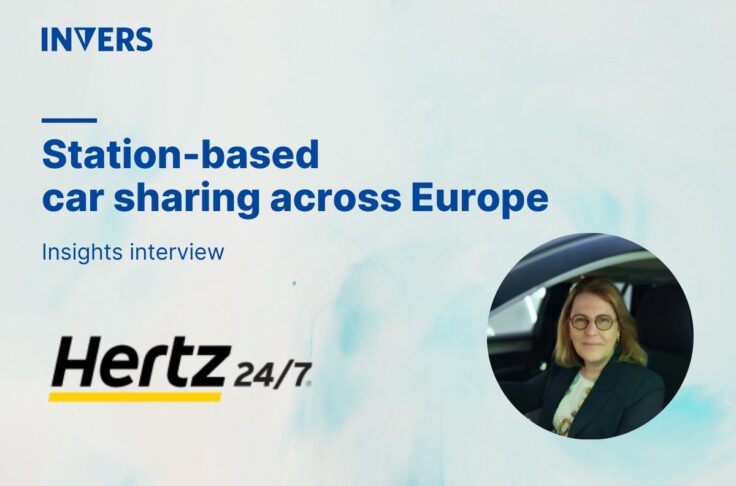Looking into the Future of Station-Based Carsharing
Summary
Station-based carsharing has proved valuable in reducing congestion and miles travelled. Even so, station-based carsharing still needs to serve non-urban areas, collaborate to build mobility hubs, and scale up their features.

Less than a decade ago, the term shared mobility was just as unfamiliar as the term sharing economy. Carsharing was a foreign concept, and that was the buzzword that would get people talking and trying to understand what it meant. Fast forward to today, and we have so many new forms of mobility that the range of options is amazing for anyone who doesn’t want to rely on a personal vehicle.
Looking closer at the carsharing space, we still see many different forms available, from free-floating to peer-to-peer. However, it is station-based carsharing that broke into the market first, and has been proven to have the greatest impact on reducing congestion and vehicle ownership. According to Tanya Bullmann, cambio CarShare:
The answer to people’s desire for a reliable yet flexible mobility option is station-based carsharing. Being able to book a vehicle in advance gives people the peace of mind they need, and helps cities build more livable, congestion-free environments.
The first form of station-based carsharing service launched in 1980, making it a relatively mature service offering compared to the new forms of mobility popping up in cities around the world. Nonetheless, the station-based carsharing space still has room to grow and continue building up its offering. For example, General Motors launched Maven last year in Toronto, and Modo now allows new drivers to use their service.
Even though station-based carsharing doesn’t generate much media attention that doesn’t mean it is no longer relevant. On the contrary, the absence in media highlights the maturity and reliability this operating model has. With research supporting its impact, station-based carsharing still has its place in the market, and will likely gain a stronger traction in the future.
Meeting Consumer Demand
What consumers want is constantly changing. Depending on living environment, economic health, and current needs, how people choose to get around is influenced by these factors. The surge in popularity of carsharing reflects this – as more people began moving into urban centres, combined with increased cost of living, priorities were reassessed. The common question was: does owning something that is only used 95% of the time make sense?
Carsharing rose in popularity because it met demands that other forms of transportation could not – convenience and freedom (Popular Mechanic). Convenience-wise, round-trip carsharing gives people the option of running their errands or going on weekend trips without having to deal with the hassles of vehicle maintenance, insurance, and gas. Instead, they just book a car when needed, and their transportation needs are met. As a result, Tanya Bullman of cambio CarShare says:
Station-based carsharing provides people the opportunity to accomplish virtually anything they would have used a personal vehicle for.
Similarly, freedom comes in the form of being able to have more choices. It’s not just about choosing how to get around, but also on managing and controlling transportation costs. When you own a vehicle, roughly 20% of your household income goes towards vehicle-related costs (Global News). However, when you use carsharing, your transportation-related costs are pay-as-you-go, and you can see the actual costs incurred for each trip.
With this transparency, people will typically find more cost-effective ways to get around. Research has shown that carsharing has allowed people to save $143-435 per month (University of California-Berkeley’s Transportation Sustainability Research Center). As a result, carsharing has enabled people to have more freedom in how they spend their income, and evaluate other options that will equally meet their need.
Congestion Reduction
Station-based carsharing is key to getting people out of personal vehicles because it is proven to reduce vehicle travel. According to UC Berkeley’s Transportation Sustainability Research Centre, one carsharing vehicle replaces 9-13 personal vehicles. This comes in the form of carsharing members selling their current vehicle, not buying a second vehicle, or postponing the purchase of a vehicle. Regardless of the reason, less personal vehicles owned means less congestion on roads.
Congestion is important to take into consideration because cities, whether urban or rural, are starting to grow. In the United States, 96.3% of the driving age population owns a vehicle; that number will cause chaos on the road if it stays the same (Globe and Mail). Instead, that number needs to be reduced, and station-based carsharing is one way to do that.
When households are part of a carsharing service, they can reduce their greenhouse gas emissions by 34-41% per year. Similarly, households can potentially reduce their vehicle miles travelled by 27-43% (UC Berkeley Transportation Sustainability Research Centre). What this translates into is more people walking, biking, taking public transit, and carpooling for their transportation needs. These options are without a doubt better for the environment, and also proven to be better for individuals as well (McKinsey & Company)
Barriers to Scaling
Even with these positive numbers highlighting the benefits carsharing, the adoption has only been 16% over the past 18 years (Meeting of the Minds). Putting market-specific factors aside, there are other factors that may have possibly prevented further growth of carsharing.
With station-based carsharing, parking agreements are required in order to have space for the shared vehicles. In dense urban cores, curbside parking and parkades are often in short supply. As a result, expanding to new locations with more vehicles require creative arrangements that identify and make use of unused spaces. Leveraging trip patterns and heat maps would also help support proposals to city officials, parking providers, and local businesses on how station-based carsharing is worth the parking space allocation.
Fleet management also poses challenges to growing a station-based carsharing service. As operations expand to cover larger areas, the logistics of maintaining vehicles need to be efficient. Currently, operators rely on manual checks and processes to determine if the vehicle needs maintenance. To avoid this time consuming process, especially as the fleet grows, a field service app would help improve efficiencies. By consolidating vehicle maintenance tasks in one view, field agents will have more information to plan their day’s duties.
The Future
What does the future of station-based carsharing look like? More operators in more cities we hope, but also with some improvements and innovation as well.
To start, we predict more corporations will share their fleet of vehicles with the public. As corporations are finding ways to become more cost-effective, the opportunity to earn revenue outside of business hours would be appealing. Instead of having the vehicle sit idle in a parking lot, the vehicle could be used by employees or others in the community, and be returned for business-use the next day.
In another scenario, station-based carsharing services could offer a ride-splitting feature that would allow members to share rides with each other. This would make the trip more affordable for all passengers, while further reducing the number of vehicles that would have to be on the road. For carsharing operators, this would help build a strong sense of community and engagement among members.
It will also be important for partnerships to form across industries. As people reduce their need for personal vehicles, the number of parking spaces needed will also decrease. With parking providers losing revenue, these spots can instead be transformed into multi-modal hubs where carsharing vehicles and other forms of new mobility can congregate. From bike shares to scooter shares to curbside ridesharing pick-up, these hubs can become community spaces filled with more parks, playgrounds, and local shops as well.
Station-based carsharing provides a solid foundation for shifting away from vehicle ownership. The freedom associated with vehicle ownership can still be found with station-based carsharing, supplemented with other forms of mobility as well. One of the greatest benefit is liberation from the personal vehicle. Station-based carsharing allows individuals to run errands and plan weekend getaways, while also being open to other forms of mobility for other trips. With this flexibility, people can better explore and appreciate the city they live in. Let’s see what the future of station-based carsharing will bring.
Station-based carsharing is proven model, and one that will act as the foundation for multi-modality.
Tanya Bullman of cambio CarShare adds, “Even with new forms of mobility popping up in cities, station-based carsharing is proven to take personal vehicles off the road and complements mass transit systems – factors that are critical in growing urban cities.”


